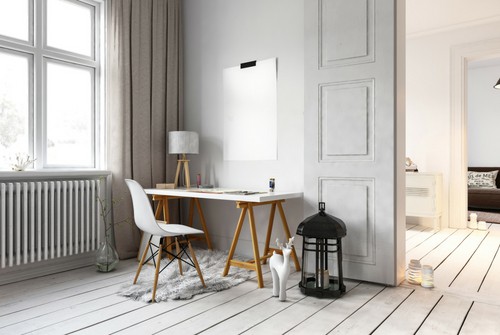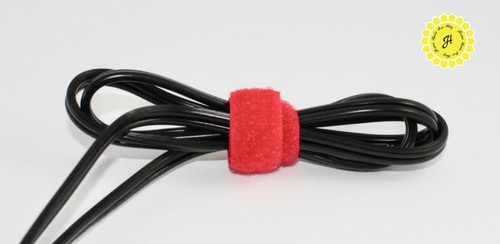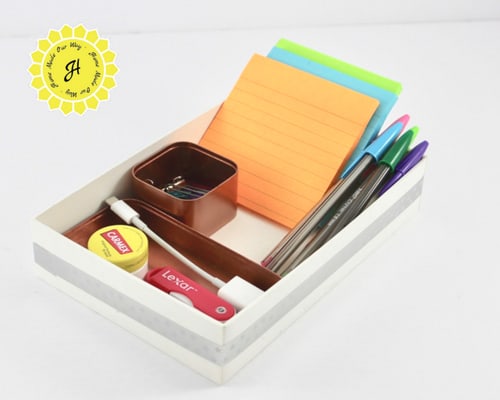Whether you work from home or just need a space to do your bills and deal with paperwork, you can create a functional and organized home office.
And don’t worry about space.
It can be done in the smallest spaces.
It’s just a matter of what you need and some creative ingenuity.

Disclosure: Some of the links below are affiliate links that I have provided for your convenience. Click here to read my full disclosure policy.
Creating an Office
If you have a spare room, then you have found your office.
But many of us don’t have that extra room and use our dining room table and even our bed to do any office work.
Let’s see if we can fix that.

Purpose
Think about why you need an office.
What things do you expect to do in your office?
This can range from just a place to pay bills or a place to run a home business.
Quickly make a list of tasks that you know you will do in your office on a daily basis.
Also, list supplies you need for your office like a printer.

Now, looking at your list, ask yourself, do you really need a whole room office?
How much space do you really need for your tasks and supplies?
If all you want is to tackle the family’s finances and incoming/outgoing mail, then a portable solution is all that you need.
I’ll go over that below.
Location, Location, Location
If you have a whole room, then skip to the Staying Organized part of this post below.
If all you require is a desk and maybe a wall organizer, go around your home or apartment and look for the perfect spot to set up your office.
It should be a quiet and well-lit spot, if possible.

Make sure that the location of your office allows for good room flow.
It should not interrupt pathways to other parts of the room or home.
Also, check to see that you have outlets nearby especially if you plan on using a computer, a printer, or need a lamp.
Office Desk Variations
If you must share your office space in a room with lots of distractions, consider purchasing a foldable screen/or room divider.
If you need a big desk but don’t have the room for one, purchase one that folds away or you might want to get creative.
See below for some space-saving ideas.
- repurpose a standing closet that you can close when you are done for the day. Just add a
shelf for your desk and use the inside walls and doors to hang assorted wall organizers such as a dry-erase board or corkboard.
- place hinges on a makeshift desktop/ledge and when you are done, just fold it up or down against the wall. You can also use a foldable chair with it so it can be stored away later.
- turn a closet into an office. You can remove the doors, insert a desk, and add shelving. Or keep the doors so that you can ‘close’ your office when not in use. Again, just make sure you have outlets available nearby.
If all you need is something like your dining room table, then create a portable caddy so that when you are done, your table is cleared off.
Check out this portable office that comes with storage for small office supplies.
Purchasing Office Fixtures
If you decide to purchase items for your office, consider pieces that are multi-purpose.
So, instead of a chair, maybe get a storage ottoman on casters that can hold files that be stored under the desk when not in use.
Purchase a lamp that has a supplies caddy attached to it and even a USB slot to use for your phone charger.
I’ve even seen Murphy beds that transform into desks and shelving.

You can use the top of your filing cabinet to hold your printer.
Attach caster wheels on the bottom of file cabinets so you can move them out of the way when you need the room.
Vertical Space
Don’t forget to take advantage of vertical space.
Put up shelving to hold your items.
You can even use a pegboard to hold your files.
Simply place small length hooks (or large length, if you can afford horizontal space) into the pegboard and place your file holder onto these.
Then place your files into the file holder.

Staying Organized
Paperwork
Try to keep your paperwork to a minimum.
Go digital and paperless as much as possible.
If you already have paperwork that needs some decluttering, click here and read: How to Organize your Paperwork.
Cords, Cords, and More Cords
Although wifi has helped with making our hardware wireless, we still have to deal with a few cords.
For large and numerous cords, consider placing cords in the walls.
You will need to purchase an in-wall cable kit so that this arrangement is up to code in your home or apartment.
To keep floors clear, try attaching cords and surge protectors to the back or underside of your desk.
Long cord? Fold up the excess and wrap it with velcro.
And to make it easy when dealing with cords, label them.
Or use different colored tags so you know which cord goes with its hardware.
Use washi tape to make them pretty, if you prefer.

Office Supplies
You can purchase a desk organizer for your supplies however, I love repurposing items.
I love the boxes that Apple products come in.
Whenever I make a purchase, I keep those boxes.
They are sturdy, come in different sizes and materials, and are perfect as desk organizers.


Don’t have access to Apple boxes? Not to worry.
You can use all kinds of packaging, especially those your grocery items come in.
Cereal boxes can sub for magazine holders or in/outboxes.
You can paint cans and pretty them up with ribbons and other notions.
Or cover them with decorative duct tape or scrapbooking paper.

I even used this gum container to hold my washi taps.

An Organized Look
The key to having an organized look is to have your bins, boxes, and other organizers match.
So if you are repurposing items, use the same color or tape to create your organizers.
For example, if you are using jars or cans to hold your supplies, you can paint them the same color so that they appear to be a set.
You also want to use matching labels and if possible, matching fonts on those labels.
This will make your office look even more organized.

And that’s it.
Are you ready to create and organize your workspace?
Then, let’s get started.
Click here to get out Project Planner to help create your office.


Leave a Reply